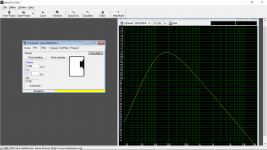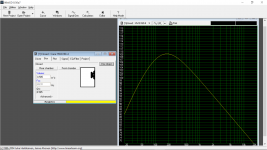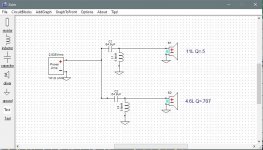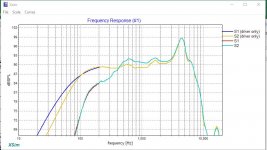I have a Ciare HWG 160-4ohm that is really more suited in a vented enclosure.
I have a 3 way cabinet design that has a sealed mid chamber of only .275 cf after all displacements (including this speaker). My question is is this going to be too damped in this small enclosure? Calculator is showing about .95 cf for sealed alignment of .707. Since the Qts is lower than the Qtc and the xmax is not too small I think it will work but just looking for opinions. I tried to model this driver on winisd but did not work will, the frequency curve was way off(not even close to linear) from what the manufacturer shows which is very flat +-3db!!
I will probably be crossing to allow usable frequencies of 200 Hz to 2k Hz. I am using a dsp with a few different crossover options so it's easy for me to play around with different xover points.
I am using a Morel CAT378 Tweeter and still playing around with
8" bass drivers, not a giant fan of Dayton but they have an 8" sub( RSS210HO-8) that
will tune flat to around 34 Hz in a 1 cf enclosure, which is what I have in
my cabinet...not as low as what I would like but my project started off very small and now it is twice as large as I was hoping!! 😱Why can't I fit a 3" x 60" port into a matchbook😱 PLEASE PARDON MY TANGENT
PLEASE PARDON MY TANGENT
I have a 3 way cabinet design that has a sealed mid chamber of only .275 cf after all displacements (including this speaker). My question is is this going to be too damped in this small enclosure? Calculator is showing about .95 cf for sealed alignment of .707. Since the Qts is lower than the Qtc and the xmax is not too small I think it will work but just looking for opinions. I tried to model this driver on winisd but did not work will, the frequency curve was way off(not even close to linear) from what the manufacturer shows which is very flat +-3db!!
I will probably be crossing to allow usable frequencies of 200 Hz to 2k Hz. I am using a dsp with a few different crossover options so it's easy for me to play around with different xover points.
I am using a Morel CAT378 Tweeter and still playing around with
8" bass drivers, not a giant fan of Dayton but they have an 8" sub( RSS210HO-8) that
will tune flat to around 34 Hz in a 1 cf enclosure, which is what I have in
my cabinet...not as low as what I would like but my project started off very small and now it is twice as large as I was hoping!! 😱Why can't I fit a 3" x 60" port into a matchbook😱
 PLEASE PARDON MY TANGENT
PLEASE PARDON MY TANGENT
Greets!
Depends on what your performance goals are.
No, according to Hornresp
it's a ~0.57 Qtc, so a ~0.577 Qtc Bessel alignment.
No way a driver with a low Qt and 0.95 ft^3 Vas in a 0.95 ft^3 cab will be max flat/0.707 Qtc, it's way over-damped at ~0.38 Qtc. HR calculates a tiny ~0.166 ft^3 as it should.
The factory frequency response appears to be a classic BR alignment @ ~+/- 2 dB [Vas/1.44, Fb = Fs] based on my HR sim.
A T/S max flat vented is a ~ 0.2536 ft^3, 59.7 Hz Fb.
Re WinISD, I've used them all and only the original wasn't very accurate, but have seen so many postings recently it makes me wonder if it's been hacked or somesuch. Guess I need to reload it and see what's what as at one time HR used it as a reference for vented, sealed IIRC, which is plenty accurate enough.
GM
Depends on what your performance goals are.
No, according to Hornresp
it's a ~0.57 Qtc, so a ~0.577 Qtc Bessel alignment.
No way a driver with a low Qt and 0.95 ft^3 Vas in a 0.95 ft^3 cab will be max flat/0.707 Qtc, it's way over-damped at ~0.38 Qtc. HR calculates a tiny ~0.166 ft^3 as it should.
The factory frequency response appears to be a classic BR alignment @ ~+/- 2 dB [Vas/1.44, Fb = Fs] based on my HR sim.
A T/S max flat vented is a ~ 0.2536 ft^3, 59.7 Hz Fb.
Re WinISD, I've used them all and only the original wasn't very accurate, but have seen so many postings recently it makes me wonder if it's been hacked or somesuch. Guess I need to reload it and see what's what as at one time HR used it as a reference for vented, sealed IIRC, which is plenty accurate enough.
GM
Yea, I figured it would not work in that small of an enclosure. I am going for as flat as possible. I just had the driver sitting here and though maybe it could be of use.
I will find a suitable driver.
BTW...is HR a worthy simulator for drivers other that bass drivers? Winisd seems to be good only for bass drivers. I don't have the $ to invest right now for a pro software.
Thanks GM!
I will find a suitable driver.
BTW...is HR a worthy simulator for drivers other that bass drivers? Winisd seems to be good only for bass drivers. I don't have the $ to invest right now for a pro software.
Thanks GM!
Sensing you missed something from GM...
Something is awry in that 0.95 cf calculation.
If I may interpret:
GM's Hornresp figures indicate your 0.275 cf enclosure yields a well-damped Qtc of 0.57.
Your calculated 0.95 cf box will not yield a Qtc of 0.707. It will yield a Qtc of ~0.38, which is way over-damped.
For a Qtc of 0.707, HR predicts a box volume of only 0.166 cf.
My manual scribbling agrees with GM. I find the same Qtc in your existing box, and a box volume of only 0.163 cf to get to a Qtc of 0.707
IMHO, since you're planning on using this driver above 200 Hz, either of these alignments or anywhere close to them is reasonable.
A couple of quick notes as a reference:
Placing a speaker in a Vb equal to its Vas will yield a Qtc of ~(1.414 x Qts)
A driver's maximum damping is achieved by the electromechanical properties of the driver itself. Placing the driver into an enclosure can only reduce damping and the smaller the box, the less damping.
So over damped = box too big, under damped = box too small
Calculator is showing about .95 cf for sealed alignment of .707.
Something is awry in that 0.95 cf calculation.
Greets!
No, according to Hornresp
it's a ~0.57 Qtc, so a ~0.577 Qtc Bessel alignment.
No way a driver with a low Qt and 0.95 ft^3 Vas in a 0.95 ft^3 cab will be max flat/0.707 Qtc, it's way over-damped at ~0.38 Qtc. HR calculates a tiny ~0.166 ft^3 as it should.
If I may interpret:
GM's Hornresp figures indicate your 0.275 cf enclosure yields a well-damped Qtc of 0.57.
Your calculated 0.95 cf box will not yield a Qtc of 0.707. It will yield a Qtc of ~0.38, which is way over-damped.
For a Qtc of 0.707, HR predicts a box volume of only 0.166 cf.
My manual scribbling agrees with GM. I find the same Qtc in your existing box, and a box volume of only 0.163 cf to get to a Qtc of 0.707
IMHO, since you're planning on using this driver above 200 Hz, either of these alignments or anywhere close to them is reasonable.
A couple of quick notes as a reference:
Placing a speaker in a Vb equal to its Vas will yield a Qtc of ~(1.414 x Qts)
A driver's maximum damping is achieved by the electromechanical properties of the driver itself. Placing the driver into an enclosure can only reduce damping and the smaller the box, the less damping.
So over damped = box too big, under damped = box too small
Last edited:
Thanks for putting things into perspective Tim.
I ran that driver earlier in Winisd and it did not like it, maybe a bug or glitch.
I just ran it again and it kinda worked, but I don't trust it...the frequency curves to
not look right. It gave me a .707 and a .577 alignment option. I will attach the screen
shots. This would be nice if it is correct, the .707 option gave me .286 cf at .702 Qtc and that is almost the exact dims of my enclosure.
But you are thinking .163 cf will get me around the .707 alignment then?
Here are the screenshots from Winisd>>
I ran that driver earlier in Winisd and it did not like it, maybe a bug or glitch.
I just ran it again and it kinda worked, but I don't trust it...the frequency curves to
not look right. It gave me a .707 and a .577 alignment option. I will attach the screen
shots. This would be nice if it is correct, the .707 option gave me .286 cf at .702 Qtc and that is almost the exact dims of my enclosure.
But you are thinking .163 cf will get me around the .707 alignment then?
Here are the screenshots from Winisd>>
Attachments
🙂Thank you GM, after conferring with Tim I realized I misunderstood you.
I appreciate your reply🙂 It looks like it magically worked out for me and that driver. LOL😀
I appreciate your reply🙂 It looks like it magically worked out for me and that driver. LOL😀
I am trying to build a +- 2 or 3 db powered speaker here so the flatter the better😀
Can't wait to get this all wired up with the dsp and start tuning!!! Thats the really fun part...I hope! Using Powersoft amps and Dsp.
Can't wait to get this all wired up with the dsp and start tuning!!! Thats the really fun part...I hope! Using Powersoft amps and Dsp.
😱You are correct, I misinterpreted what he was telling me!😱
Thanks for pointing that out.
If you can't tell I have not figured out the "QUOTE" thing yet.
Thanks for pointing that out.
If you can't tell I have not figured out the "QUOTE" thing yet.
Maybe I'm missing something, but for the purposes of a sealed mid in a 3-way, Q is almost meaningless. The Q of the box essentially controls the LF response which matters little in a 3-way because you are going to use a HP filter on it and roll it off anyways.
Now if you go with a very high Q with a small box, that is going to create some peaking and that will affect the response you are working with, but even that can be taken care of in the xo. You will however increase the stiffness of the internal air spring the driver sees. Maybe that will help depending on the driver, but chances are since the driver is not going to see much in the way of LF's, it therefore will not see much cone excursion and therefore the extra restoring force of a low compliance box won't be needed.
For me in this situation, choosing a box size big enough to properly absorb the rear wave energy while still allowing enough room to let the driver breath take the top priority. Where the box Q ends up isn't quite that important as long as it isn't something extreme, ie. anywhere between .5 and .7 should be fine.
Now if you go with a very high Q with a small box, that is going to create some peaking and that will affect the response you are working with, but even that can be taken care of in the xo. You will however increase the stiffness of the internal air spring the driver sees. Maybe that will help depending on the driver, but chances are since the driver is not going to see much in the way of LF's, it therefore will not see much cone excursion and therefore the extra restoring force of a low compliance box won't be needed.
For me in this situation, choosing a box size big enough to properly absorb the rear wave energy while still allowing enough room to let the driver breath take the top priority. Where the box Q ends up isn't quite that important as long as it isn't something extreme, ie. anywhere between .5 and .7 should be fine.
I don't think you're missing much. The main idea here was to be sure the existing box was OK.
However, a 200Hz HP is still low enough to be concerned about keeping Fc down and Qtc reasonable. That's only an octave above Fc with Qtc of 0.707 for this driver.
Not mentioned before, but since he's using a 6½" capable of going pretty low, I think it's also wise to plan for the possibility of going an octave lower than planned in the end.
All IMO, of course.
However, a 200Hz HP is still low enough to be concerned about keeping Fc down and Qtc reasonable. That's only an octave above Fc with Qtc of 0.707 for this driver.
Not mentioned before, but since he's using a 6½" capable of going pretty low, I think it's also wise to plan for the possibility of going an octave lower than planned in the end.
All IMO, of course.
I have chamfered the back of the baffle so the driver can breathe well, and I have some Roxul Rockboard 60 that I will place behind the driver, and also line the walls with some 2" mineral wool. Both are open cell... I think that will take care of most all reflections and the back wave from re entering the cone. Will be a dead cabinet.Maybe I'm missing something, but for the purposes of a sealed mid in a 3-way, Q is almost meaningless. The Q of the box essentially controls the LF response which matters little in a 3-way because you are going to use a HP filter on it and roll it off anyways.
Now if you go with a very high Q with a small box, that is going to create some peaking and that will affect the response you are working with, but even that can be taken care of in the xo. You will however increase the stiffness of the internal air spring the driver sees. Maybe that will help depending on the driver, but chances are since the driver is not going to see much in the way of LF's, it therefore will not see much cone excursion and therefore the extra restoring force of a low compliance box won't be needed.
For me in this situation, choosing a box size big enough to properly absorb the rear wave energy while still allowing enough room to let the driver breath take the top priority. Where the box Q ends up isn't quite that important as long as it isn't something extreme, ie. anywhere between .5 and .7 should be fine.
I will do the update. Do you know if any driver I have loaded in the database will still be there after the update?
Thanks, as I did not realize I had the older version😱
Greets!
Depends on what your performance goals are.
No, according to Hornresp
it's a ~0.57 Qtc, so a ~0.577 Qtc Bessel alignment.
No way a driver with a low Qt and 0.95 ft^3 Vas in a 0.95 ft^3 cab will be max flat/0.707 Qtc, it's way over-damped at ~0.38 Qtc. HR calculates a tiny ~0.166 ft^3 as it should.
The factory frequency response appears to be a classic BR alignment @ ~+/- 2 dB [Vas/1.44, Fb = Fs] based on my HR sim.
A T/S max flat vented is a ~ 0.2536 ft^3, 59.7 Hz Fb.
Re WinISD, I've used them all and only the original wasn't very accurate, but have seen so many postings recently it makes me wonder if it's been hacked or somesuch. Guess I need to reload it and see what's what as at one time HR used it as a reference for vented, sealed IIRC, which is plenty accurate enough.
GM
Do you recommend HR for mid drivers and Hi frequency drivers?
Just to illustrate the point I was trying to make, here is what the driver looks like with Q of .5 and Q of .707 with a filter added. Box volumes are without any fill based on Response Modeler. In pic 2, 'driver only' is before the xo filter is added and S1 and S2 are with a random 2nd order electrical HP aimed somewhere near 200Hz.
The result is - it makes no difference.
Now I like the absorption strategy. I would just suggest decreasing the density closer to the driver. And by breathing I meant give the driver some space right behind it, then start layering in the insulation. The Rockboard is great stuff but even it needs to be decently thick to absorb down near 125Hz. I've used more than a couple of inches on the back wall in the past. I'm still trying to figure out if the driver sees the stuff as more permeable or more of a solid because the density is so high.
The result is - it makes no difference.
Now I like the absorption strategy. I would just suggest decreasing the density closer to the driver. And by breathing I meant give the driver some space right behind it, then start layering in the insulation. The Rockboard is great stuff but even it needs to be decently thick to absorb down near 125Hz. I've used more than a couple of inches on the back wall in the past. I'm still trying to figure out if the driver sees the stuff as more permeable or more of a solid because the density is so high.
Attachments
- Home
- Loudspeakers
- Multi-Way
- Sealed midrange/midbass too damped??



